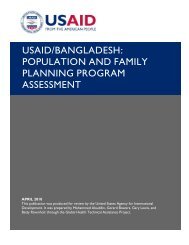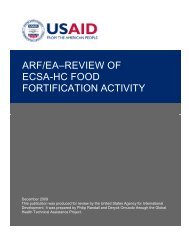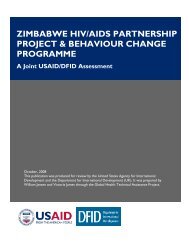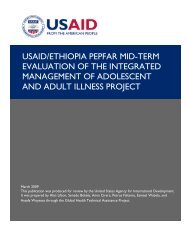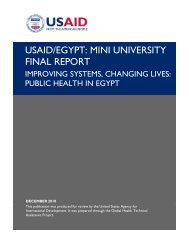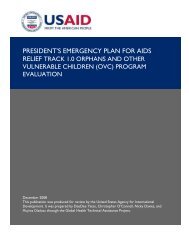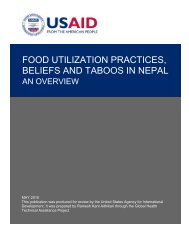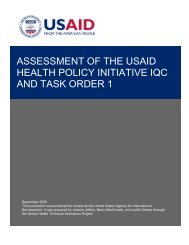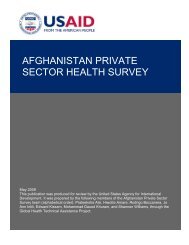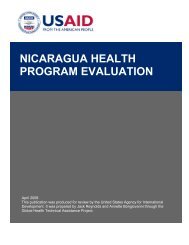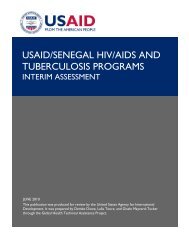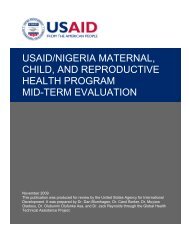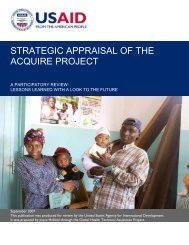value this coordinated approach to <strong>TB</strong>, and it has been suggested as a model for o<strong>the</strong>r healthprograms (e.g., HIV/AIDS, malaria).<strong>TB</strong>CTA’s final report was published in 2007.THE <strong>TB</strong> <strong>CAP</strong> PROJECT (2006–2010)In 2005 USAID requested applications for a <strong>TB</strong> <strong>Control</strong> <strong>Assistance</strong> <strong>Program</strong> (<strong>TB</strong> <strong>CAP</strong>) to expand upon<strong>the</strong> work <strong>of</strong> <strong>TB</strong>CTA, giving more emphasis to <strong>TB</strong>/HIV integrated approaches, involving new partners at<strong>the</strong> country level (especially <strong>the</strong> private sector), and improving drug management systems. <strong>TB</strong> <strong>CAP</strong> wasalso expected to have an effective monitoring and evaluation (M&E) system to streng<strong>the</strong>n programplanning. It would emphasize building human, institutional, and financial capacity for DOTSimplementation that could be sustained past <strong>the</strong> life <strong>of</strong> <strong>the</strong> project.The <strong>TB</strong> <strong>CAP</strong> project was awarded to KNCV, which signed a second cooperative agreement with USAID.The <strong>TB</strong> <strong>CAP</strong> cooperative agreement covers September 2005–September 2010 and has a total estimatedvalue <strong>of</strong> US$150 million.KNCV’s six subgrantees are <strong>the</strong> American Thoracic Society (ATS), Family Health International (FHI),International Union Against <strong>Tuberculosis</strong> and Lung Disease (The Union), Japan Anti-<strong>Tuberculosis</strong>Association (JATA), Management Sciences for Health (MSH), and <strong>the</strong> WHO. The Centers for Disease<strong>Control</strong> (CDC) is a member <strong>of</strong> <strong>the</strong> coalition but funds for this agreement do not flow to or through CDC.A description <strong>of</strong> KNCV and its <strong>TB</strong> <strong>CAP</strong> subgrantee partners is located in Annex 1 (Scope <strong>of</strong> Work) tothis report.<strong>TB</strong> <strong>CAP</strong> assistance has two purposes: (1) to improve and expand <strong>the</strong> capacity <strong>of</strong> USAID to respond to <strong>the</strong>global <strong>TB</strong> epidemic by providing well-coordinated state-<strong>of</strong>-<strong>the</strong>-art, context-appropriate, technicallysound, and cost-effective consultation and TA to high-prevalence countries and Missions, and to buildadditional global capacity for providing TA; and (2) to complement and expand global <strong>TB</strong> control efforts,such as those advocated by <strong>the</strong> Stop <strong>TB</strong> Partnership. The ultimate goal is to maximize efforts to accelerate<strong>the</strong> pace <strong>of</strong> DOTS expansion to meet global targets, in collaboration with o<strong>the</strong>r global <strong>TB</strong> partners. <strong>TB</strong><strong>CAP</strong> has <strong>the</strong> following goals in countries where it invests:90% <strong>of</strong> public clinics implementing DOTSAt least 70% case detection rateAt least 85% treatment success rate and/or cure rate75% <strong>of</strong> countries meeting MDR <strong>TB</strong> quality standards as defined by <strong>TB</strong> <strong>CAP</strong>100% <strong>of</strong> countries effectively coordinating nationwide <strong>TB</strong> and HIV programs.<strong>TB</strong> <strong>CAP</strong>’s five intermediate results (IRs) areIR 1: Increased political commitment for DOTSIR 2: Streng<strong>the</strong>ned and expanded DOTS programsIR 3: Increased public and private DOTS participation and collaborationIR 4: Increased and streng<strong>the</strong>ned <strong>TB</strong> and HIV/AIDS coordinated activitiesIR 5: Improved human and institutional capacity.2 EVALUATION OF THE TUBERCULOSIS CONTROL ASSISTANCE PROGRAM (<strong>TB</strong> <strong>CAP</strong>)
II.EVALUATION PURPOSE AND METHODOLOGYIn 2009 USAID commissioned <strong>the</strong> Global Health Technical <strong>Assistance</strong> (GH Tech) Project toindependently evaluate <strong>TB</strong> <strong>CAP</strong>’s performance, impact, and lessons learned against <strong>the</strong> project’sobjectives and its contribution to <strong>the</strong> objectives <strong>of</strong> <strong>the</strong> Stop <strong>TB</strong> Partnership. The evaluation was intendedto analyze common factors, patterns for success, and areas for improvement. It was charged withanswering <strong>the</strong>se principal questions:What is <strong>the</strong> evidence that <strong>TB</strong> <strong>CAP</strong> has or will have helped accelerate DOTS expansion to reachglobal targets and build institutional and individual capacity for <strong>TB</strong> control in targeted countries?Is this <strong>the</strong> optimal framework for a multifaceted mechanism within <strong>the</strong> Stop <strong>TB</strong> Partnership, takinginto consideration USAID’s comparative advantages?The results were to be used to provide feedback to <strong>TB</strong> <strong>CAP</strong> on project operations and management andrecommendations to <strong>TB</strong> <strong>CAP</strong> and USAID on doing <strong>the</strong> work better. The evaluation was also to informUSAID on design <strong>of</strong> future <strong>TB</strong> activities.THE EVALUATION PROCESSThe four-person consultant team consisted <strong>of</strong> Dr. Stephen C. Joseph (team leader), Dr. Fabio Luelmo, Mr.Timothy Ryan, and Dr. Stanley Scheyer. One team member first carried out a desk audit <strong>of</strong> <strong>TB</strong> <strong>CAP</strong>documents and materials and gave <strong>the</strong> report to <strong>the</strong> team as work began. 3 The team was also grantedaccess to <strong>the</strong> <strong>TB</strong> <strong>CAP</strong> E-room <strong>of</strong> project documents, managed by <strong>the</strong> KNCV PMU.Two team members attended <strong>the</strong> meeting <strong>of</strong> <strong>the</strong> <strong>TB</strong> <strong>CAP</strong> Board <strong>of</strong> Directors February 18–19, 2009, andpre-evaluation meetings were held with <strong>TB</strong> <strong>CAP</strong> Project Managers. During <strong>the</strong> week <strong>of</strong> March 10–14, <strong>the</strong>full team ga<strong>the</strong>red in The Hague, Ne<strong>the</strong>rlands, at <strong>the</strong> PMU/KNCV headquarters for extensive briefings by<strong>the</strong> PMU and for planning <strong>the</strong> evaluation. Separate questionnaires (Annex III) were formulated to guideinterviews and country visits with <strong>the</strong> three key referent groups: Mission staff, country coordinatingpartners, and National <strong>Tuberculosis</strong> <strong>Program</strong> (NTP) managers. After those meetings, two team memberscarried out a field visit in Indonesia, a third visited WHO in Geneva and <strong>the</strong> headquarters <strong>of</strong> <strong>the</strong> Union inParis for intensive discussions, and <strong>the</strong> fourth returned to Washington to lay <strong>the</strong> groundwork for anextensive series <strong>of</strong> telephone interviews.Two team members <strong>the</strong>n visited Nigeria, Mozambique, and Uganda. Each visit began with 1-2 days <strong>of</strong>meetings in <strong>the</strong> capital with USAID and national and <strong>TB</strong> <strong>CAP</strong> partner representatives. This was followedby 2-3 days <strong>of</strong> fieldwork, usually in rural areas at a considerable distance from <strong>the</strong> capital, to observe <strong>the</strong><strong>TB</strong> control activities <strong>of</strong> both <strong>TB</strong> <strong>CAP</strong> and o<strong>the</strong>r organizations. During each visit, health and <strong>TB</strong> controlactivities were observed at all levels <strong>of</strong> <strong>the</strong> health system: community health workers and DOTSvolunteers, DOTS and general activities at primary and secondary health centers, and district and regionalhospitals. Informational discussions were held with <strong>TB</strong>, health, and governance authorities at each level.At DOTS sites <strong>the</strong> team looked at clinical screening and treatment, laboratory activities and registers,clinical and <strong>TB</strong> control registers, patient follow-up, supervision <strong>of</strong> community volunteers, and stockageand distribution <strong>of</strong> drugs. The final phase <strong>of</strong> each visit consisted <strong>of</strong> 1-2 days <strong>of</strong> meetings and debriefingsin <strong>the</strong> capital and visits to national reference laboratories, training sites, and drug procurement andstockage facilities. There were discussions with PEPFAR personnel on <strong>TB</strong>/HIV coordination, and withCDC personnel on survey and research activities.3 The desk audit (Annex II) is available from USAID as a separate document.EVALUATION OF THE TUBERCULOSIS CONTROL ASSISTANCE PROGRAM (<strong>TB</strong> <strong>CAP</strong>) 3



